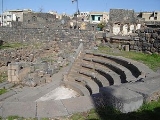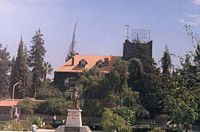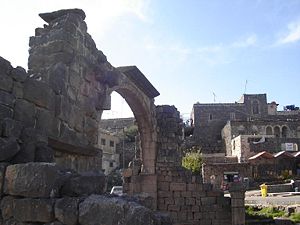
As Suwayda
Encyclopedia
As Suwayda also spelt Sweida, is a mainly Druze
city located in southwestern Syria
, close to the border with Jordan
.
It is the capital of Muhafazat as Suwayda
, one of Syria's 14 governorate
s, bordering Jordan in the South and the governorates of Daraa in the West and Rif Dimashq
in the North and East.

with a prominent Greek orthodox
minority, The population of the city is estimated at 63,324 (2008).
as Suada. It became known as Dionysias (Greek
: Διονύσιας) in the Hellenistic
and Roman
times, for Dionysus
the god of wine
- the city is situated in a famous ancient wine-producing region.
The name Dionysias replaced the former Nabatean name of Suada in 149 AD after the Nabataean influence decreased and then concentrated towards the south, as a result of the accelerating Hellenization
of Coele-Syria
at that time.
Dionysias was a part of the Roman province
of Arabia Petraea
, and received the rights of civitas
under the reign of Commodus
between 180–185.
Dionysus
was worshipped in the same Nabatean temple dedicated for Dushara
. This practice of associating the worship of local and Hellenic gods was common in Hellenistic Syria.
This name remained in use during the Byzantine
period, when the town was under the influence of Ghassanids
, Dionysias then was a Diocese
as a suffragan of Bosra
. It was mentioned in the Synecdemus
of Hierocles
. After the Arab conquests it became a titular see
.
In recent times Dionysias was firstly identified as Sweida by William Henry Waddington
.
 Many archeological remains can be found in the old part of Sweida including:
Many archeological remains can be found in the old part of Sweida including:
The city has also many Roman time old houses that are still inhabited by locals, ancient reservoirs, and watch towers.
Many parts of the old city are still to be excavated like the Roman aqueduct, a conical reservoir, and a larger Roman amphitheatre
.
Druze
The Druze are an esoteric, monotheistic religious community, found primarily in Syria, Lebanon, Israel, and Jordan, which emerged during the 11th century from Ismailism. The Druze have an eclectic set of beliefs that incorporate several elements from Abrahamic religions, Gnosticism, Neoplatonism...
city located in southwestern Syria
Syria
Syria , officially the Syrian Arab Republic , is a country in Western Asia, bordering Lebanon and the Mediterranean Sea to the West, Turkey to the north, Iraq to the east, Jordan to the south, and Israel to the southwest....
, close to the border with Jordan
Jordan
Jordan , officially the Hashemite Kingdom of Jordan , Al-Mamlaka al-Urduniyya al-Hashemiyya) is a kingdom on the East Bank of the River Jordan. The country borders Saudi Arabia to the east and south-east, Iraq to the north-east, Syria to the north and the West Bank and Israel to the west, sharing...
.
It is the capital of Muhafazat as Suwayda
As Suwayda' Governorate
As-Suwayda is the southernmost of Syria's 14 governorates. It has an area of 5,550 km² and forms part of the historic Hawran region. Its capital and major city is As-Suwayda....
, one of Syria's 14 governorate
Governorate
A governorate is an administrative division of a country. It is headed by a governor. As English-speaking nations tend to call regions administered by governors either states, provinces, or colonies, the term governorate is often used in translation from non-English-speaking administrations.The...
s, bordering Jordan in the South and the governorates of Daraa in the West and Rif Dimashq
Rif Dimashq
Rif Dimashq is one of the 14 governorates of Syria. It is situated in the southwestern part of the country. It borders the governorates of Quneitra, Daraa and al-Suwayda in the southwest, Homs in the north, Lebanon in the west and Jordan in the south.The Governorate completely surrounds the...
in the North and East.

Demographics and Population
The inhabitants of the city are mainly DruzeDruze
The Druze are an esoteric, monotheistic religious community, found primarily in Syria, Lebanon, Israel, and Jordan, which emerged during the 11th century from Ismailism. The Druze have an eclectic set of beliefs that incorporate several elements from Abrahamic religions, Gnosticism, Neoplatonism...
with a prominent Greek orthodox
Eastern Orthodox Church
The Orthodox Church, officially called the Orthodox Catholic Church and commonly referred to as the Eastern Orthodox Church, is the second largest Christian denomination in the world, with an estimated 300 million adherents mainly in the countries of Belarus, Bulgaria, Cyprus, Georgia, Greece,...
minority, The population of the city is estimated at 63,324 (2008).
History
The city was founded by the NabataeansNabataeans
Thamudi3.jpgThe Nabataeans, also Nabateans , were ancient peoples of southern Canaan and the northern part of Arabia, whose oasis settlements in the time of Josephus , gave the name of Nabatene to the borderland between Syria and Arabia, from the Euphrates to the Red Sea...
as Suada. It became known as Dionysias (Greek
Greek language
Greek is an independent branch of the Indo-European family of languages. Native to the southern Balkans, it has the longest documented history of any Indo-European language, spanning 34 centuries of written records. Its writing system has been the Greek alphabet for the majority of its history;...
: Διονύσιας) in the Hellenistic
Hellenistic civilization
Hellenistic civilization represents the zenith of Greek influence in the ancient world from 323 BCE to about 146 BCE...
and Roman
Roman Empire
The Roman Empire was the post-Republican period of the ancient Roman civilization, characterised by an autocratic form of government and large territorial holdings in Europe and around the Mediterranean....
times, for Dionysus
Dionysus
Dionysus was the god of the grape harvest, winemaking and wine, of ritual madness and ecstasy in Greek mythology. His name in Linear B tablets shows he was worshipped from c. 1500—1100 BC by Mycenean Greeks: other traces of Dionysian-type cult have been found in ancient Minoan Crete...
the god of wine
Wine
Wine is an alcoholic beverage, made of fermented fruit juice, usually from grapes. The natural chemical balance of grapes lets them ferment without the addition of sugars, acids, enzymes, or other nutrients. Grape wine is produced by fermenting crushed grapes using various types of yeast. Yeast...
- the city is situated in a famous ancient wine-producing region.
The name Dionysias replaced the former Nabatean name of Suada in 149 AD after the Nabataean influence decreased and then concentrated towards the south, as a result of the accelerating Hellenization
Hellenization
Hellenization is a term used to describe the spread of ancient Greek culture, and, to a lesser extent, language. It is mainly used to describe the spread of Hellenistic civilization during the Hellenistic period following the campaigns of Alexander the Great of Macedon...
of Coele-Syria
Coele-Syria
Coele-Syria , or Cœle-Syria or Celesyria, traditionally given the meaning 'hollow' Syria, was the region of southern Syria disputed between the Seleucid dynasty and the Ptolemaic dynasty. Rather than limiting the Greek term to the Beqaa Valley of Lebanon, it is often used to cover the entire area...
at that time.
Dionysias was a part of the Roman province
Province
A province is a territorial unit, almost always an administrative division, within a country or state.-Etymology:The English word "province" is attested since about 1330 and derives from the 13th-century Old French "province," which itself comes from the Latin word "provincia," which referred to...
of Arabia Petraea
Arabia Petraea
Arabia Petraea, also called Provincia Arabia or simply Arabia, was a frontier province of the Roman Empire beginning in the 2nd century; it consisted of the former Nabataean kingdom in modern Jordan, southern modern Syria, the Sinai Peninsula and northwestern Saudi Arabia. Its capital was Petra...
, and received the rights of civitas
Civitas
In the history of Rome, the Latin term civitas , according to Cicero in the time of the late Roman Republic, was the social body of the cives, or citizens, united by law . It is the law that binds them together, giving them responsibilities on the one hand and rights of citizenship on the other...
under the reign of Commodus
Commodus
Commodus , was Roman Emperor from 180 to 192. He also ruled as co-emperor with his father Marcus Aurelius from 177 until his father's death in 180. His name changed throughout his reign; see changes of name for earlier and later forms. His accession as emperor was the first time a son had succeeded...
between 180–185.
Dionysus
Dionysus
Dionysus was the god of the grape harvest, winemaking and wine, of ritual madness and ecstasy in Greek mythology. His name in Linear B tablets shows he was worshipped from c. 1500—1100 BC by Mycenean Greeks: other traces of Dionysian-type cult have been found in ancient Minoan Crete...
was worshipped in the same Nabatean temple dedicated for Dushara
Dushara
Dushara , also transliterated as Dusares, was an aniconic deity in the ancient Middle East worshipped by the Nabataeans at Petra and Madain Saleh . He was mothered by Manat the goddess of fate. In Greek times, he was associated with Zeus because he was the chief of the Nabataean pantheon as well as...
. This practice of associating the worship of local and Hellenic gods was common in Hellenistic Syria.
This name remained in use during the Byzantine
Byzantine
Byzantine usually refers to the Roman Empire during the Middle Ages.Byzantine may also refer to:* A citizen of the Byzantine Empire, or native Greek during the Middle Ages...
period, when the town was under the influence of Ghassanids
Ghassanids
The Ghassanids were a group of South Arabian Christian tribes that emigrated in the early 3rd century from Yemen to Syria, Jordan, Lebanon and the Holy Land....
, Dionysias then was a Diocese
Diocese
A diocese is the district or see under the supervision of a bishop. It is divided into parishes.An archdiocese is more significant than a diocese. An archdiocese is presided over by an archbishop whose see may have or had importance due to size or historical significance...
as a suffragan of Bosra
Bosra
Bosra , also known as Bostra, Busrana, Bozrah, Bozra, Busra Eski Şam, Busra ash-Sham, and Nova Trajana Bostra, is an ancient city administratively belonging to the Daraa Governorate in southern Syria...
. It was mentioned in the Synecdemus
Synecdemus
The Synecdemus or Synekdemos is a geographic text, attributed to Hierocles, which contains a table of administrative divisions of the Byzantine Empire and lists of the cities of each. The work is dated to the reign of Justinian but prior to 535, as it divides the 912 listed cities in the Empire...
of Hierocles
Hierocles (author of Synecdemus)
Hierocles or Hierokles was a Byzantine geographer of the sixth century and the attributed author of the Synecdemus or Synekdemos, which contains a table of administrative divisions of the Byzantine Empire and lists of the cities of each...
. After the Arab conquests it became a titular see
Titular see
A titular see in various churches is an episcopal see of a former diocese that no longer functions, sometimes called a "dead diocese". The ordinary or hierarch of such a see may be styled a "titular bishop", "titular metropolitan", or "titular archbishop"....
.
In recent times Dionysias was firstly identified as Sweida by William Henry Waddington
William Henry Waddington
William Henry Waddington was a French statesman who was Prime Minister of France in 1879.-Early life and education:...
.
Archaeology

- Temple of Dionysus-Dushara: eight well-decorated columns are still standing from the temple.
- Saint Sergius Basilica: was built in the fifth century A.D. It has ByzantineByzantineByzantine usually refers to the Roman Empire during the Middle Ages.Byzantine may also refer to:* A citizen of the Byzantine Empire, or native Greek during the Middle Ages...
architecture elements, with an abbey surrounding it. The basilica was dedicated to Saint Sergius.
- The arch of the lesser church: the church itself is ruined. An arch is still standing there known locally as Al Mashnaqa with grape motif decorations.
- The amphitheatre: was recently discovered, south of the AgoraAgoraThe Agora was an open "place of assembly" in ancient Greek city-states. Early in Greek history , free-born male land-owners who were citizens would gather in the Agora for military duty or to hear statements of the ruling king or council. Later, the Agora also served as a marketplace where...
.
The city has also many Roman time old houses that are still inhabited by locals, ancient reservoirs, and watch towers.
Many parts of the old city are still to be excavated like the Roman aqueduct, a conical reservoir, and a larger Roman amphitheatre
Amphitheatre
An amphitheatre is an open-air venue used for entertainment and performances.There are two similar, but distinct, types of structure for which the word "amphitheatre" is used: Ancient Roman amphitheatres were large central performance spaces surrounded by ascending seating, and were commonly used...
.

